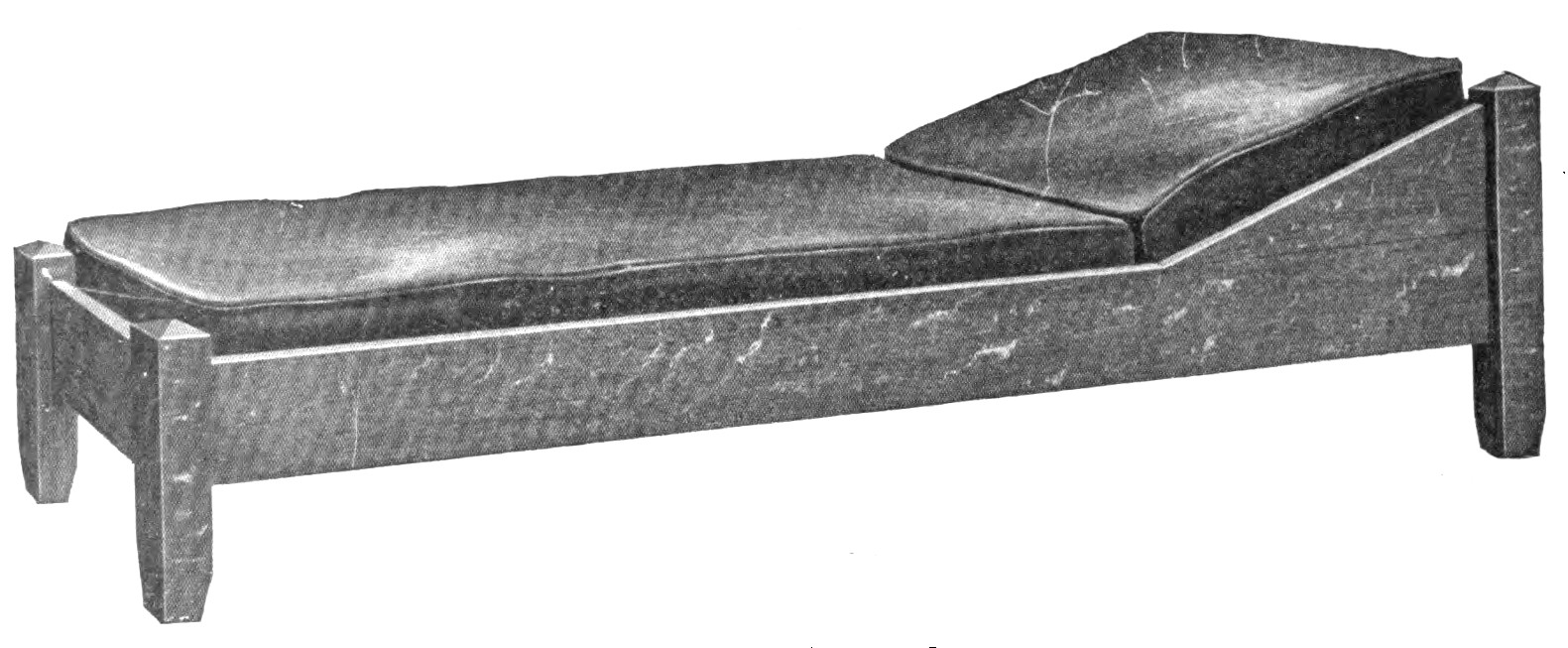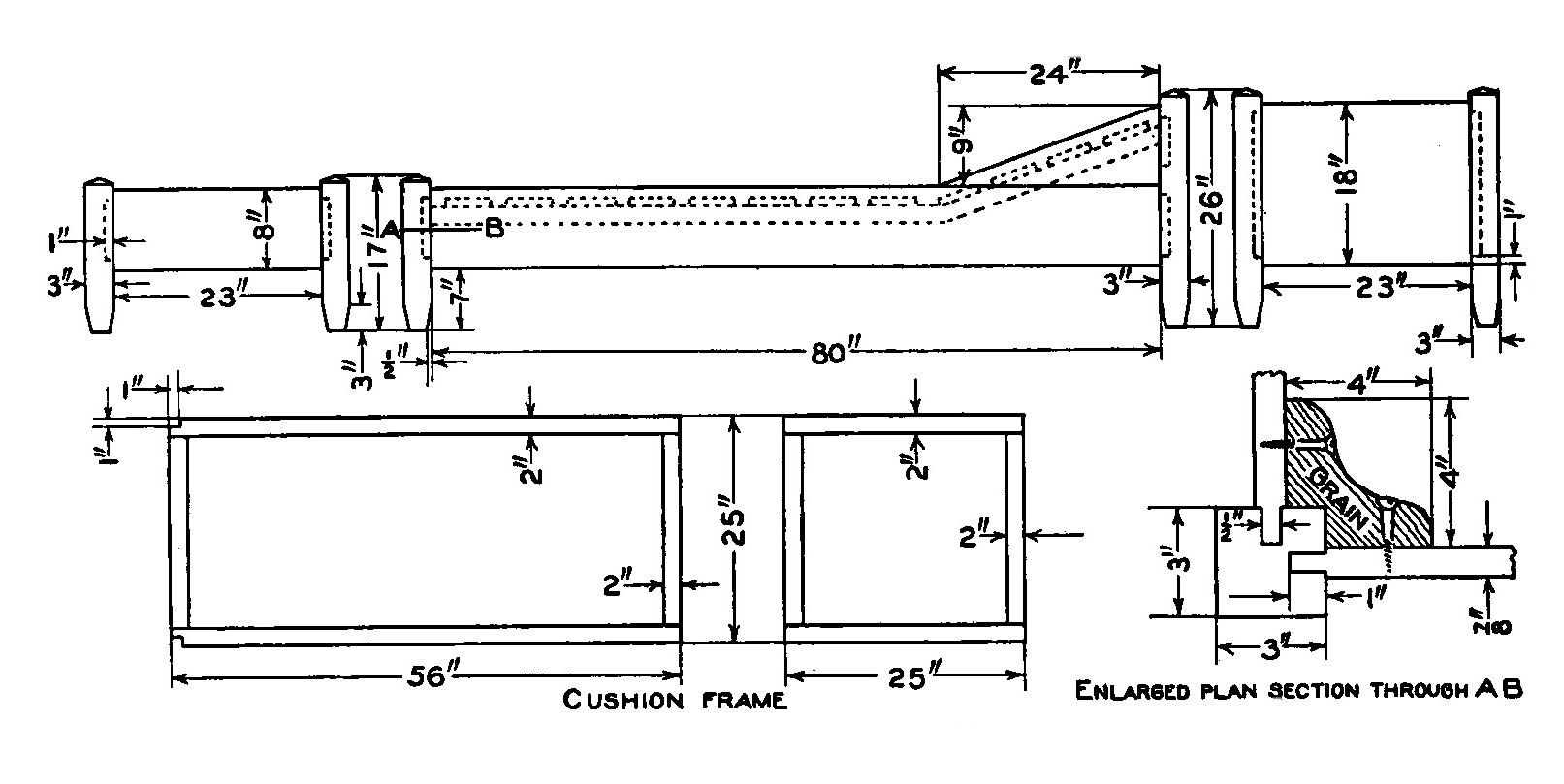| AN
OAK COUCH WITH CUSHIONS
This beautiful
piece of
mission furniture can be made at a very moderate cost, if the
material used for the cushions is of good imitation leather. These
substitutes for leather last fully as long and the difference can
only be detected by an expert. White oak will give the best results
except for the frames or slats on which the cushions rest and these
may be made of poplar or pine. If a mill or woodworking shop of any
kind is handy, the hardest part of the work can be saved by securing
the following list of material, cut, planed, sanded and squared up to
the exact sizes given:
2 posts, 3 in. square by
17 in.
2 posts, 3 in.
square by
26 in.
2 rails, 7/8 by 8
by 82
in.
1 rail, 7/8 by 8 by
25
in.
1 end, 7/8 by 18 by
25
in.
1 piece, 7/8 by 9
by 24
1/2 in.
The last piece
on the
list when sawed diagonal makes the two slanting pieces at the head of
the couch. The corner braces are made from two pieces of
straight-grained oak, 2 by 4 1/2 by 4 1/2 in., sawed on the diagonal,
and cut as shown in the enlarged plan section to make the four
pieces.
First be sure
the legs
are perfectly square, the two short ones and the two long ones of
equal length respectively. Either chamfer or round the upper ends as
desired, chisel and plane the taper on the lower ends. Lay out and
cut all the tenons on the rails — 1 in. is the amount allowed at
each end in the stock dimensions given. Arrange the posts and rails
in the positions they are to occupy in the finished couch. Number
each tenon and the place its corresponding mortise is to be cut in
the post. Mark each mortise directly from the tenon which is to fit
into it, taking care to have all the rails an equal distance from the
floor. Bore and chisel out all mortises and see that all the rails
fit perfectly, before proceeding with the work.

The
Couch Complete
The next step will
be to
fit in the slanting side pieces at the head of the couch. These must
be let into the long posts 1/2 in. and held also by a dowel in the
side rail. In order to get these pieces into place, the mortise in
the long post must be made 1/2 in. longer than the tenon on the
sloping side piece so the tenon may be first pushed into the mortise
and then the side clamped down on the rail over the dowel. The whole
couch should fit together perfectly before gluing any of the parts.
Glue the end
parts
together first. Hot glue will hold best if the room and lumber are
warm; if these cannot be had, use cold glue. After the ends have set
for at least 24 hours, glue in place the side rails and slanting head
pieces. Screw in place the corner braces. Be sure when making these
braces to have the grain running diagonally across the corner, or the
brace will be weak, also, be sure the sides are square with the ends;
this may be determined by measuring the diagonals to find if they are
equal.
If it is decided
to use
frames for the cushions, then the following material will be
necessary:
2 pieces, 7/8 by 2 by 56
in.
2 pieces, 7/8 by 2
by 25
in.
4 pieces, 7/8 by 2
by 21
in.
This material
may be of
pine or poplar. These pieces are made into two frames as shown in the
drawing and held together with long screws or nails. Fasten with glue
and screw short blocks on the inside of the couch rails for holding
the two frames in place. Tack pieces of cheap burlap across the frame
and cover with ordinary black cambric. This will give a strong,
springy rest for the cushions.
Should slats be
used
instead of frames for holding. the cushions, then the following list
of material should be substituted for the frame material list:
2 cleats, 7/8 by 2 by 56
in.
2 cleats, 7/8 by 2
by 25 in.
12 slats, 7/8 by 5
by 25
in.
The materials
listed may
be of soft wood the same as for the frame. The cleats are fastened to
the inside of the rails of the couch with screws, so the top edge
will be 2 in. lower than the top edge of the rails. The slats are
spaced evenly on these cleats.
After the glue
is all
set, remove the clamps and scrape off any glue that may be on the
wood. If this glue is not removed it will keep the stain from
entering the wood, which will show up when finished in white spots.
This couch may
be stained
in any of the shades of brown or dark to harmonize with its lines of
construction. A water stain will penetrate the wood best and after
this is applied and thoroughly dried the surface should be well
sanded to remove the roughness of the raised grain. Apply one coat of
thin shellac and when this is dry, put on two coats of wax.
In making up the
cushions, use either hair or elastic felt for the filling.

(Click for larger image) |

